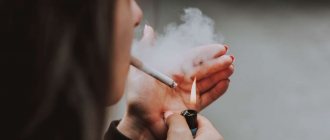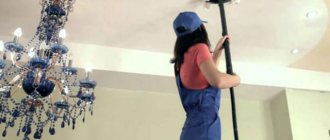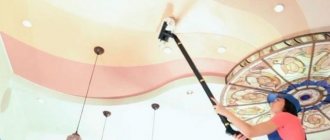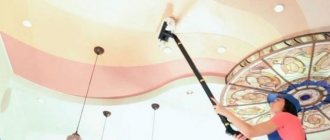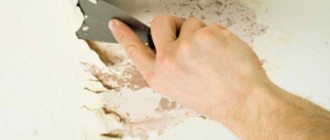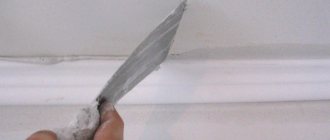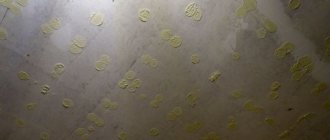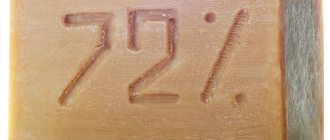Stretch ceilings seem fragile and susceptible to damage, and even installation experts say that this structure requires careful handling. Therefore, owners of such finishing in the house are lost when a stain appears on the film or fabric. This article will talk about how to restore cleanliness yourself using various means and techniques, and when you can’t do without a replacement.
How to remove soot from a stretch ceiling
It will not be possible to remove soot from a stretch ceiling with a simple sponge.
To make stretch ceilings, materials with an antistatic coating are used; cobwebs and small dry particles do not stick to them. But in the kitchen there is high humidity, specific fumes and fumes. Even a good hood does not always prevent soot, smoke, steam and other external factors from settling on the ceiling.
Causes of pollution
During the operation of the premises, the following are formed on the tension surface:
- yellow stains from grease and soot above the stove;
- brown residue from tobacco smoke;
- traces of flies;
- rusty spots from condensation on pipes;
- stains that form when the roof leaks or water leaks from neighbors above.
https://www.youtube.com/watch?v=icy-XSpBLPg
It is necessary to wash suspended ceilings from soot and soot so as not to damage them. Therefore, before starting work, remove jewelry from your hands.
When working with aggressive agents, you need a mask, gloves and goggles
Prepare the necessary equipment:
- water bucket;
- a stable stepladder;
- rags for washing;
- mop with foam roller;
- a brush with soft bristles.
For your own safety you need the following:
- thick rubber gloves;
- eye protection glasses;
- respirator;
- headdress;
- long-sleeved work clothes.
As soon as traces of dirt appear on the ceiling, they must be washed immediately, because old stains are harder to remove than fresh ones.
You can wash the hanging cloth with any degreasing liquid for dishes. Before doing this, carefully read the instructions - the product should not contain abrasive particles.
The following grease removers are suitable: Myth, Eared Nyan, Gala, Fairy, Pril, Pur. Aerosol detergents for washing glass, mirrors, and crystal will help maintain the original shine.
To remove soot and soot, it is better to use Master Cleaner. In addition, special aerosols and sprays of the Altezza brand have been developed. The aerosol is applied to the black spot, left in place according to the instructions included with the product, and washed off with clean water using a soft sponge. A product designed for washing car seats removes stains from soot and grease well.
Folk remedies
If it is not possible to use industrial chemicals for cleaning, then you can wash suspended ceilings in the kitchen using traditional methods.
Soot, soot, and grease are easily removed by ordinary soap solution. To do this, dilute laundry soap or washing powder in warm water and wash the fabric with soft, gentle movements.
Places where a particularly large amount of soot and soot have accumulated are treated with copper sulfate dissolved in water 1:1. When finished, rinse off with clean water and wipe dry.
There are other effective home recipes:
- Vodka – returns shine to a glossy canvas if used in a 1:10 ratio with water.
- Soap solution - works well to remove stains caused by nicotine.
- Ammonia – dissolves greasy stains.
- Hydrogen peroxide - quickly removes stains from tomato, tea or wine.
Aromatic components are added to eliminate the smell of nicotine or burning.
Soda contains solid particles that can damage the tension surface. It has a strong cleaning effect and can change the color of the canvas. Therefore, soda cannot be used for washing stretched glossy fabric, but for fabric and matte fabric it can be used by first dissolving it in water 1:5.
Often stains appear in the kitchen from soot, burning gas, grease, nicotine, and flies. In this case, simple wet cleaning is not enough. Use available products for spot removal of stains of various origins.
How to clean a suspended ceiling
From fat
The ceiling in the kitchen especially suffers from grease stains. To remove them, use dishwashing gel:
- Drop some gel onto the sponge.
- Treat the oily area.
- Wait 15-20 minutes.
- Wipe with a damp sponge to remove the product.
- Wipe dry with microfiber.
Also, ammonia and ammonia water remove fat.
From paint
You can wash water-based paint and primer after repairs using a soap solution. Dilute a few drops of dishwashing gel in water and wipe the surface with a damp cloth. The method is applicable to textile and vinyl ceilings.
We suggest you read: How to insulate the ceiling in a house or bathhouse with expanded clay
If waterproof paint gets on the surface, prepare the mixture:
- Mix starch and PVA glue in equal proportions.
- Apply the mixture using a roller.
- Place sheets of paper on top.
- Leave until dry.
Along with the drying glue, the paint will begin to come off, remaining on the paper.
Try softening oil paint with vegetable oil.
Do not use solvents: part of the coating will come off along with the paint.
If all else fails, all that remains is to replace the piece of damaged ceiling. To prevent this from happening, seal the baseboards and ceiling edges with construction tape before painting the walls.
From glue, tape
Removing glue, especially dried glue, is problematic. First soak paper stickers with water. Rub the adhesive stain with an eraser, and then with glass cleaner, turpentine or suspended ceiling cleaner.
We wash off the tape and glue
If all else fails, carefully try removing the adhesive with mineral spirits or a melamine sponge.
Remember, white spirit can corrode the layer, and a sponge can damage the glossy surface.
A soap, alcohol-containing solution or a special aerosol will save you from tobacco smoke. To get rid of the smell of cigarettes, add natural flavoring to the liquid - ground coffee, mint, citric acid.
From soot
Wash away soot deposited from the stove or after a fire with soapy water. You can use liquid or the resulting thick foam. If the stains are absorbed, pre-soak them with water. Finish cleaning with an alcohol-containing liquid to make the smooth surface shiny.
Note. To avoid cleaning the ceiling from soot and nicotine stains, install a powerful hood.
Yellow stains are caused by tobacco smoke. Nicotine gradually settles on the ceiling, resulting in a yellowish layer. Fortunately, minor deposits can be easily cleaned with ordinary soap. The most serious deposits can only be cleaned with special cleaning agents. means for cleaning suspended ceilings or alcohol-containing products (glass cleaning liquid). After cleaning, the alcohols will evaporate in a short time and will not leave any traces.
How to wash a suspended ceiling made of fabric and PVC: means and methods
You can wash the ceiling at home using improvised means. Alcohol and soap solutions work well to remove stains.
Eraser
Without using liquids, clean matte surfaces with an eraser. Without pressing, rub away the dark stains. Brush off the gum pellets and rinse with a damp, soft cloth.
Wiper
This is a universal liquid for cleaning polyvinyl chloride suspended ceilings. The liquid removes dirt and polishes the vinyl layer to a shine. Arm yourself with a soft cloth and a spray bottle of liquid. Spray and wipe dry immediately.
Soap solution
To remove dust and cigarette smoke, prepare soapy water. Completely dilute laundry detergent, dish gel or soap shavings in warm water. Better plan your hand soap: laundry soap contains a large amount of alkali, which has a detrimental effect on delicate surfaces. For ease of cleaning, use a mop with closed corners.
Washing the ceiling with a mop
How to mop a ceiling:
- Whisk the solution to form a thick foam.
- Collect the foam onto the mop.
- Wipe the ceiling, moving in one direction.
- Without waiting for the soap to dry, wipe with clean water.
Try not to put pressure on the mop. Finish cleaning with a dry wipe to remove excess moisture.
Water alcohol
Prepare an alcohol solution by mixing one part of vodka, ethyl or ammonia with ten parts of water. Rub the solution onto the ceiling in the kitchen or living room. After the procedure, open the windows for ventilation.
The solution can be used after washing with soap to get rid of stains.
Ammonia hydrate
Caustic ammonia or ammonia water can be purchased at a pharmacy. The liquid removes greasy stains well. It is not necessary to dilute with water. Apply the product to a cotton pad or microfiber and gently rub the stain. Leave for a while and wipe with a damp sponge.
Note. Before washing, remove rings, bracelets, watches that may damage the surface. Wear protective gloves.
Expert advice
To simply and quickly clean a canvas made of any material, you must adhere to the following recommendations:
- so that after washing, the glossy ceiling regains its original shine, it is wiped with a solution of medical or ammonia;
- movements should be performed only along the location of the seam;
- before performing the specified work, remove all rings and bracelets so that you cannot damage the canvas with them;
- there must be a hood in the kitchen, and during cooking, you must use lids, then soot and grease will not fall on the ceiling;
- Do not use abrasives;
- When cleaning, do everything carefully and do not use much force.
Features of cleaning suspended ceilings
To clean the ceiling from dust and stains, prepare in advance:
- stepladder or stable chair;
- soft rags (microfiber);
- washcloths or sponges;
- water container;
- cleaners;
- vacuum cleaner with a soft bristle brush;
- rubber gloves, headscarf.
If you don't have a stepladder, use a telescopic mop. Do not use abrasives, dry powders, aggressive agents (Domestos), steel wool, or hard brushes on the ceiling surfaces.
Carry out dry cleaning weekly, wet cleaning as needed. For regular cleaning, use a dry cloth, vacuum cleaner, steam generator or sponge with clean water. Do not press on the surface while cleaning. Wipe stubborn stains locally with soapy water or an alcohol-containing substance. Be sure to rinse off the cleaner and absorb moisture with a dry microfiber. When washing, move along the seam.
We suggest you read: How pipes are passed through a suspended ceiling
What not to do?
Here's what you shouldn't do if you decide to wash a matte stretch ceiling:
- use hot water - the water temperature should not exceed 40 °C;
- use abrasive detergents and materials;
- wash the ceiling with acetone-based products - it dissolves PVC film;
- use hard or sharp objects and hard brushes for washing;
- resort to using a mop - the risk of damaging the tension covering in this case is quite high;
- use only approved detergents;
- Do not use stain remover without first testing it on a small area of the film that is hidden from view.
Types of pollution
Soot
This type of contamination often appears in the kitchen. This is due to the fact that the kitchen is designed for frequent cooking. There is nothing you can do about it; frequent cleaning of the ceiling will help you with this. To clean such stains, use dishwashing or glass detergent. First, you need to treat the stains with the product and leave for 3-4 minutes. Then dirt can be easily removed by wiping with a soft sponge.
Most often, dust accumulates on the ceiling in the summer. Very often it can be found in open spaces (balconies, loggias). Therefore, frequent wet cleaning is recommended in these rooms. Also, a lot of dust and paint accumulates after a room is renovated. Dust can be quickly removed with a vacuum cleaner with a brush attachment. When cleaning, the vacuum cleaner nozzle should be 1-2 cm from the ceiling so as not to stick to the surface. To prevent the vacuum cleaner from drawing material inside, it is best to wrap the nozzle with cloth. Work must be carried out at medium speed of the device. Wet cleaning technology:
- A damp cloth (cotton or flannel) is wrapped around the mop so that it does not fall off.
- The mop is placed in such a position that there is light contact with the ceiling. It is not recommended to press with force to avoid damaging the material.
- The movement of the mop should be in a straight line in the “backward” direction.
Grease stains mainly appear in the kitchen area around the stove when cooking. Cleaning is carried out in the same way as cleaning soot and soot. Experts advise: before washing greasy stains at home, they need to be moistened with a soap-foam solution.
Marker
To clean the ceiling from the marker, use alcohol-containing solutions. You need to apply the solution several times to avoid streaks. Rinse with plain water and wipe dry. Minor dirt can be easily removed with a steam cleaner. After such cleaning, condensation will form, which must be wiped dry with a dry cotton cloth.
To reduce dirt sticking to the ceiling, it needs to be treated with WD 40
To protect the tension fabric from contamination and not injure it by frequent washing, you must:
- install a good hood in the kitchen;
- do not smoke indoors;
- handle champagne and other “firing” drinks carefully;
- When cooking, cover the dishes with a lid to prevent fat from splashing;
- once a year treat the canvas with an antistatic agent to prevent dust from settling on it;
- get rid of flies in a timely manner;
- Do wet cleaning of the premises regularly.
If the film is free of stains from grease, soot and flies, washing is not necessary; it is enough to remove the dust with a vacuum cleaner without touching the surface of the film.
Stretch ceilings are practical. And if you treat them with care, they will last for many years.
Basic Rules
Stretch matte ceilings are made of PVC film impregnated with polyurethane. Thanks to this impregnation, a special texture of the material is formed. Polyurethane is known as a dust-repellent and waterproofing agent, which prevents large amounts of dust from accumulating on it.
The frequency of cleaning depends on the size and purpose of the room. The living room, hall and bedroom do not require constant care and washing of the ceilings, because difficult-to-remove contaminants do not accumulate here. Stretch ceilings installed in kitchens and dining rooms are highly susceptible to contamination (grease stains, soot, condensation). Therefore, such rooms need to be cleaned much more often. The same problem occurs in the bathroom, where moisture sometimes causes mold or mildew to form.
Professional products
When choosing which product to clean the ceiling with, pay attention to the composition. Most suspended ceilings are made of PVC, which is sensitive to alkalis, acids, and abrasives. Buy alcohol-containing products, gels, sprays. Examples of what can be used to clean the ceiling are given in the table.
Table 1. Professional products
| Name | Photo | Manufacturer | Volume, ml | price, rub. |
| EdelWeiss | Russia | 500 | 200 | |
| Nouvelle | Russia | 500 | 150 | |
| LOC from Amway | USA | 1000 | 530 | |
| "Mister Muscle" | Russia | 500 | 250 | |
| Ceruttist | Russia | 500 | 620 |
Important. To test how a surface reacts to a substance, apply the liquid to an inconspicuous area. Rub and let dry. If the color and structure have not changed, the product is safe.
Various materials
Stretch ceilings are made from two types of materials.
The ceiling material is made from polyester. This material has the ability to stretch in any direction. The basis of the material is polyester threads, which are coated with a polymer composition and painted in a variety of color palettes. It is believed that fabric ceilings are more reliable and durable than film ceilings. They are not translucent due to the thickness of the fabric. They are not demanding to wash; the fabric can withstand high levels of dirt and stress. The impregnations included in the design are considered an environmentally friendly material. Fabric ceilings do not accumulate moisture, as a result of which this coating breathes. If, however, the fabric ceiling is persistently soiled, follow the advice of experts:
- Fabric should not be cleaned with products containing alcohol and acetone (glass and mirror cleaners).
- Washing is carried out only with movements in a straight line away from you; if you move the rag in a circle, a large number of soap stains will form.
- As a last resort, washing the fabric with a powder solution is allowed.
PVC ceiling
Polyvinyl chloride is an elastic material that has the ability to quickly recover from deformation. Thanks to its natural composition, dirt and dust practically do not accumulate on this ceiling. It is also resistant to alcohol elements, acid and salt solutions, and fire. It is easy to press and returns to its original shape. Extreme care and caution is required when cleaning such material. It is better to clean PVC sheets manually without using a mop. The use of cleaning mixtures containing acetone is prohibited. Under the influence of such a solution, the film will simply disappear. Depending on the type of material used, the ceiling can be:
- Glossy.
- Matte.
We suggest you read: How to properly build a bathhouse
Stretch ceilings are produced with built-in spotlights of various shapes, which also require care and treatment. Before cleaning spotlights, you need to disassemble them according to the instructions:
- De-energize the room.
- If the design of the lamp includes two rings (external and internal), then both are extended.
- To disconnect the light bulb from the socket, you need to loosen it and carefully remove it.
To clean the lamps from dirt, you must follow the recommendations:
- The area where the appliances are located is washed carefully by hand without a mop.
- If water gets on the surface of the lamp, immediately remove it with a dry cloth.
Lamps are washed with special soap. solutions, after which the devices are rinsed with water. Glass and mirror cleaners are also suitable for cleaning. Before installing lighting devices into the structure, it is necessary to dry the devices.
Useful tips:
- Before starting work, be sure to remove jewelry and jewelry from your hands.
- If there are dried pieces of food on the ceiling, it is better to soak them in a cleaning solution for a few minutes and then remove them.
- Cosmetics can be easily removed with ammonia.
- Splashes from champagne, juice and various household products will be difficult to remove. To do this, use a soft sponge and soap solution.
- Fabric ceilings are cleaned more vigorously, while film ceilings are cleaned more carefully.
- All work must be carried out in special clothing that protects against the ingress of cleaning solutions: latex or rubber gloves, a headscarf, safety glasses.
- If minor rust formation is detected, immediately clean the ceiling covering, preventing the contamination from being absorbed into the material.
- The optimal temperature of cleaning solutions is 30-40 degrees. If water temperature is high enough, the material will deteriorate or become deformed.
- The seams of the ceiling covering are washed only lengthwise, circular movements are prohibited. If moisture gets inside the seams, the surface will deform and the gloss will become uneven.
- It is recommended to remove cobwebs from corners by hand, as using a mop or vacuum cleaner can lead to tearing and deformation of the ceiling covering.
Proper care of stretch ceilings ensures a longer service life.
To learn how to easily wash a suspended ceiling, see the following video.
When wondering whether a stretch ceiling can be washed, consider the material it is made of. There are two types of suspended ceilings:
- textile made of polyester;
- PVC film.
Fabric ceilings are difficult to clean with detergents without streaks. They are cleaned exclusively using a dry method. PVC is a water-resistant material that will survive washing with water. Let's take a closer look at how best to wash different types of ceilings.
Black
The black ceiling can be cleaned perfectly with any means
A black stretch ceiling can be washed with any of the above products, except soap, otherwise whitish stains will remain. You can remove them using clean water and an alcohol-containing glass cleaner.
Over time, white ceilings fade and turn yellow. Due to the flood, rust stains are forming in the corners of the neighbors above. First, try washing off the yellow discoloration with soapy water. If this does not help, treat the flood marks with a weak bleach solution. Pour a tablespoon of “Whiteness” into a liter of warm water. Blot the dirt with a soft cloth and leave to dry. Re-process the remaining stains.
Textile
The easiest way to clean a fabric ceiling without streaks is with a vacuum cleaner. To remove dust, hold the brush at a distance of two to three centimeters from the canvas. Do not press the brush against the surface to avoid damaging the layer.
Clean velvet and fleecy ceilings with a steam cleaner, for example. Use a soft floor nozzle. Turn on the device to the minimum temperature. In addition to the ceiling, you can clean chandeliers (unscrew the light bulb first) and tiles in the bathroom using this method. A hot steam jet removes dirt and disinfects.
Cleaning steps
Complete general cleaning and cleaning of suspended ceilings involves a certain algorithm for performing actions and going through several mandatory stages at once.
- Dry wipe. This is necessary to remove surface contaminants and prepare the base for the next steps. Most often designed to remove dust, wet splashes, cobwebs and stuck particles. A good tool will help restore shine to dull areas.
- Chemical exposure. This phase is the most important and responsible point. At this stage, detergents are used, the scrubbing and removal of stubborn stains and stains of long-standing origin occurs. When performing such actions, windows and other sources of draft are closed to prevent rapid drying out.
- Wet wipe. This stage involves washing off foaming substances and eliminating accompanying stains. Pure warm water is used without any additional additives. A cold liquid will not remove all soap marks, but too hot a liquid can ruin the material and cause the film to bubble and shrink. For better results, this procedure is carried out several times.
- Wiping dry. After all the stages indicated above, the penultimate phase is the complete elimination of drops, splashes and traces of water. If this is not done carefully, residual moisture will be absorbed and damage the integrity and quality of the product. As a result of such problems, the air in the room becomes too humid, and there is a risk of mold or mildew.
- Ventilation. The last important point represents the final stage of cleaning. To ensure that unnecessary odors disappear and unnoticed wet areas dry out, vents, windows, balconies, and doors are opened. Air conditioning and ventilation systems will also have an additional effect.
After completing work, the room needs to be ventilated
Cleaning procedures are not limited to the selection of suitable cleaning products, cleaning tools and step-by-step cleaning instructions. In order for the effectiveness to be at the highest level, all necessary actions aimed at eliminating dirt and stains must obey general rules.
- The dry type of wiping is used every 2-3 months, depending on the degree of clouding of the canopy, and the wet version is used approximately once every six months, except in cases of urgent need.
- Cleaning with chemical products is carried out using smooth, soft circular movements - this makes it easier to get rid of dried stains and greasy marks. But removing residual moisture requires movements in a back and forth direction - this will ensure the elimination of streaks.
- Do not press hard, rub intensively or scrape the material.
- For better comfort, you need to immediately roughly divide the entire area into several separate sectors and clean them gradually one after another.
- Damaged areas require special care and delicacy, so you need to wash them very carefully or entrust such care to professionals.
- Before working with hazardous substances, it is advisable to check the reaction of the paint and material to the chemical composition. To do this, select a small, inconspicuous area and apply a few drops of cleaning liquid to it. If any changes appear within 20 minutes, the substance must be discarded.
How to scrub from the inside?
Basically, the appearance of internal stains on a suspended ceiling is caused by rust, because the ceiling slab has reinforcement in its design. Causes of the problem: flooding, high humidity, roof leaks. They appear in multi-storey buildings due to the fact that the interfloor ceilings have not dried completely and moisture has begun to destroy the metal. Dealing with such pollution is quite difficult.
If the level of contamination is insignificant, it is recommended to apply a little greasy clay or soda ash solution until it dries completely. Afterwards, rinse all ingredients with clean water. If contaminants are not completely removed, repeat the procedure again. In the most difficult situations, it is necessary to dismantle the ceiling covering, clean the inner surface of debris and dust, and rinse with warm water. If necessary, use soap.
Tags: soot, tension, wash, ceiling
« Previous entry
Types of cleaning
There are several main types of ceiling cleaning, the choice of which depends on the degree of contamination and the type of room.
- Dry. For this variety, clean, unwetted tools are used. The main essence of this option is wiping to remove recently appeared or minor dirt. This technique is not suitable for dried traces. Typically, the described method gets rid of dust, cobwebs, fresh splashes and condensation drops. This method does not require heavy and prolonged physical activity, so it is also used for preventive purposes.
Dry cleaning of matte stretch ceiling - Wet. Requires more careful and diligent action using spray detergents. Plain boiled water or water-based solutions are also used for this type of washing. This method obliges apartment owners to select a rather meticulous selection of tools. Ignoring this requirement complicates the entire work process and calls into question its effectiveness.
- Steam. Not suitable for all rooms. The steam is directed to a specific point, after which the condensation is quickly wiped off. If the formed drops are not eliminated immediately, the coating becomes saturated with moisture beyond measure. It noticeably loses quality and attractiveness and deteriorates. When using this method, you need to take care of other things in the room so that wet air does not get on them.
Example of a steam cleaning tool - Combined. This category includes the gradual application of several methods at once. They resort to sequential use of dry and wet types of cleaning. Washing suspended ceilings in this way has better efficiency and leaves the coating clean for a long time. This approach is used when it is necessary to remove the most difficult stains to remove.
The choice of method also depends on the type of material of matte ceilings. Tissue samples require an individual approach for each variety. For example, some types of coating are strictly prohibited from steam exposure, while others, on the contrary, require a mixed cleaning option.
The durability of matte ceiling coatings is still higher than that of glossy ones, which makes them easier to work with. Sometimes different methods are selected for individual areas. In other cases, you can limit yourself to only one washing method. It is important to remember that the incorrect selection of tools and techniques spoils the material and negatively affects the entire structure.
